#techo nationalism
Photo









National Neopian Discount Cards
Blumaroo Basic
Moehog Standard
Buzz Super
Elephante Bronze
Techo Silver
Kau Gold
Kougra Platinum
Scorchio Universal
Korbat Stellar
#neopets#blumaroo#moehog#buzz#elephante#techo#kau#kougra#scorchio#korbat#national neopian#2000s#y2k#old web#my post
13 notes
·
View notes
Text
NEOPET GAMES THAT WORK
These are games that currently work with
THIS CHROME EXTENSION.
Working means you can both play it AND earn neopoints. There are some games that are somewhat playable but bugged, or you are unable to earn neopoints with them. Some games don’t work at all. I will not be listing those games here. Some of these will be one of the 14 fixed games in the current game room. I am including them because the old game room still has the featured game function, allowing you to earn double the points by playing it from the old link. I hope this makes you as happy as it did me. c:
I would click each one and add them to your favorite game list to make things easier later on.
AAA’s Revenge
Attack of the Revenge
Bagatelle
Mynci Beach Volleyball
Biscuit Brigade: Hagan's Last Stand
Neverending Boss Battle
Bruno's Backwoods Breakaway
Ultimate Bullseye II
Bumble Beams
The Buzzer Game
Carnival of Terror
Escape from Meridell Castle
Caves and Corridors: Mystery Island
Chemistry for Beginners
Chia Bomber 2
Faerie Cloud Racers
Coconut Shy
Crisis Courier
Dar-BLAT!!!
Defender Trainer
Edna's Shadow
The Castle of Eliv Thade
Evil Fuzzles from Beyond the Stars
Extreme Herder
Eye of the Storm
Faerie Bubbles
Faerie Caves II - Fyora's Quest
Fashion Fever
Feed Florg
Flycatcher
Freaky Factory
Gadgadsgame
Igloo Garage Sale
Ghost Bopper
Goparokko
Gormball
Grand Theft Ummagine
Attack of the Gummy Dice
Gwyl's Great Escape
Hasee Bounce
Hubrid's Hero Heist
Hungry Skeith
Ice Cream Machine
Imperial Exam
Itchy Invasion
Jolly Jugglers
Jubble Bubble
Meepit Juice Break
Kass Basher
Kiko Match II
Kiss The Mortog
Escape to Kreludor
MAGAX: Destroyer II
Magma Blaster
Attack of the Marblemen
Maths Nightmare
Meepit vs. Feepit
Meerca Chase II
Mootix Drop
Mop 'n' Bop
NC Shopping Race (AD)
Trouble at the National Neopian
Nimmos Pond
Skies Over Meridell
Petpet Rescue
Petpet Cannonball
Piper Panic
Pterattack
The Great Qasalan Caper
Revel Roundup
Rink Runner
Roodoku
Ruins Rampage
Scamander Swarm
Smug Bug Smite
Snowbeast Snackrifice
Snow Wars II
Snowball Fight
Snowmuncher
Sophie's Stew
Lost in Space Fungus
Spell-Or-Starve
Splat-A-Sloth
Stowaway Sting
Strength Test
Sutek's Tomb
Swarm - The Bugs Strike Back
TNT Staff Smasher
Techo Says
Time Tunnel
Toy Box Escape
Tug 'O' War
Turmac Roll
Typing Terror
Tyrannian Mini Golf
Usuki Frenzy
The Usul Suspects
Volcano Run II
Warf Rescue Team
Web of Vernax
Whirlpool
Wicked Wocky Wobble
Word Pyramid
296 notes
·
View notes
Text

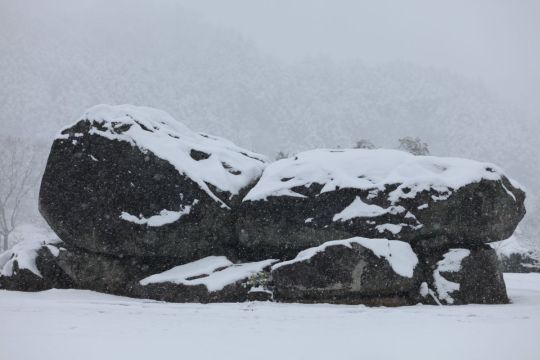

Sean bienvenidos a un nueva entrega un tanto especial, ya que tengo el gusto de presentaros Ishibutai, localizado en la prefectura de Nara data del periodo Asuka(592-710).
-
En un principio se barajaron hipótesis de que podría haber sido utilizado para espectáculos, en la década de los 30, Ishibutai es un kofun y os estaréis preguntando ¿no se supone que tenían ojo de cerradura?
-
Los podian a ver de muchos tipos se empiezan a construir en el año 300 al 592 d.c pero eso será otro capítulo de la arqueología y prehistoria japonesa.
La tumba pudo pertenecer a Soga no Umako un político y ocupa una extensión de 54 m es la mayor estructura megalítica conocida en Japón.
-
¿Hasta cuando estuvo utilizada? la edad de uso os dejará helados se construyó en el siglo VI y estuvo hasta el siglo VII para ser más exactos en este segundo dato en el 626 d.c.
-
En 1957 fue nombrado patrimonio nacional por la Unesco, ¿Cuánto pesa esta mole? un total de 30 rocas que le suman un peso aproximadamente de 2300 toneladas y las piedras del techo suman una friolera de 77 toneladas aproximadamente.
-
Espero que os haya gustado y nos vemos en una nueva publicación de arqueología y prehistoria arqueología japonesa.
-
Welcome to a new, somewhat special installment, as I have the pleasure of introducing you to Ishibutai, located in the Nara prefecture, dating from the Asuka period (592-710). - At first, hypotheses were considered that it could have been used for shows, in the 1930s, Ishibutai is a kofun and you may be wondering, aren't they supposed to have a keyhole? - You could see them of many types, they began to be built in the year 300 to 592 AD but that will be another chapter of Japanese archeology and prehistory. The tomb could have belonged to Soga no Umako, a politician, and occupies an area of 54 m, it is the largest megalithic structure known in Japan. - Until when was it used? The age of use will leave you frozen. It was built in the 6th century and was there until the 7th century to be more exact in this second data in 626 AD. - In 1957 it was named a national heritage site by UNESCO. How much does this mass weigh? a total of 30 rocks that add up to a weight of approximately 2,300 tons and the stones of the roof add up to a whopping 77 tons approximately. - I hope you liked it and see you in a new publication of archeology and prehistory Japanese archaeology.
-
新しい、ちょっと特別な回へようこそ。今回は、飛鳥時代 (592 ~ 710 年) に遡る、奈良県にある石舞台についてご紹介したいと思います。 - 当初は、1930 年代にショーに使用されたのではないかという仮説が考えられていました。 石舞台は古墳ですが、鍵穴があるはずではないかと疑問に思うかもしれません。 - さまざまなタイプのそれらを見ることができ、それらは西暦 300 年から 592 年に建てられ始めましたが、それは日本の考古学と先史学の別の章となるでしょう。 この墓は政治家蘇我馬子の墓と考えられ、面積は54メートルあり、知られている巨石建造物としては日本最大である。 - いつ頃まで使われていましたか? この 2 番目のデータは西暦 626 年で、6 世紀に建てられ、より正確には 7 世紀まで存在していました。 - 1957 年にユネスコによって国家遺産に指定されましたが、この塊の重さはどれくらいでしょうか? 30 個の石を合計すると約 2,300 トン、屋根の石を合計すると約 77 トンにもなります。 - 気に入っていただければ幸いです。考古学と先史時代の日本の考古学の新しい出版物でお会いしましょう。
#先史時代#原史時代#メガリス#歴史#日本の歴史#考古学遺跡#考古学者#考古学#日本#人類の歴史#県#県ジャポン#ピリオダスカ#ピリオドコフン#墓#クラノガ#ソガノウマコ#prehistoria#protohistoria#megalito#historia#historiajapón#restosarqueológicos#arqueólogo#arqueologas#japan#japón#historiadelahumanidad#prefecturas#prefecturasjapon
54 notes
·
View notes
Text
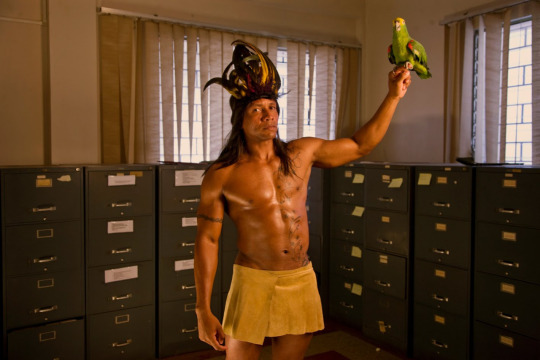

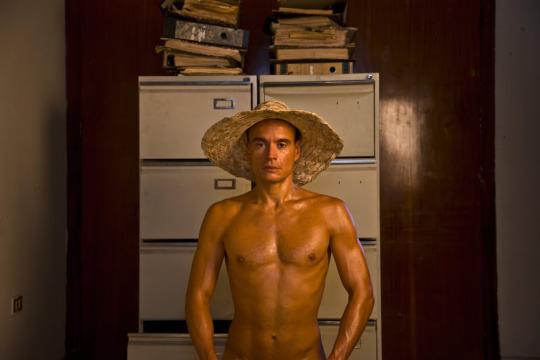
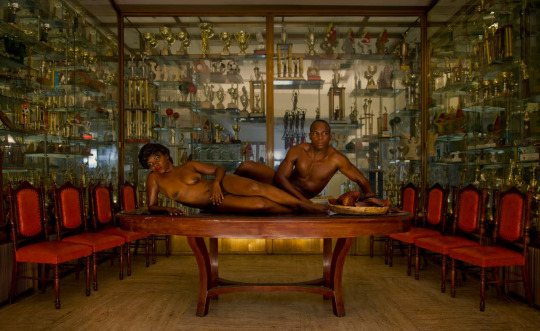
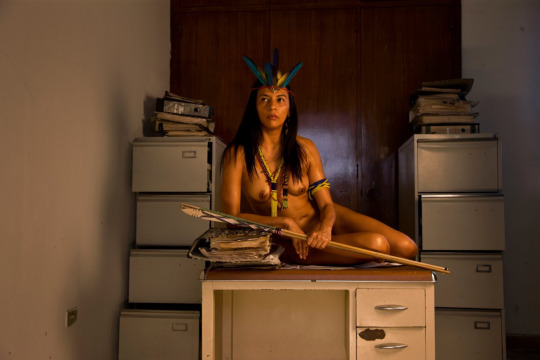



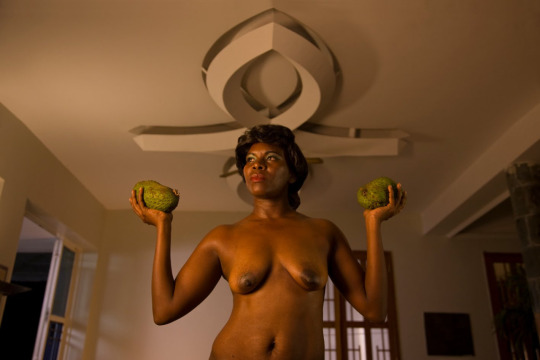

Ensayando la Postura Nacional by Alexander Apóstol
Based on the paintings of Pedro Centeno Vallenilla
Caracas experienced a strong urban construction growth after the death of the dictator Juan Vicente Gómez in 1936 until the 70´s. Important political changes: European and Latin-American migrations, and especially petroleum costs variations made Venezuelan mentality change at a speeding race to new perspectives that were demonstrated in different areas, architecture being the main element of change towards a modern city. Besides the big social differences, from then on, the Venezuelans have conceived to an extreme this modern period of time as the dream of a better future.
In that time, important plastic artist irrupted during the 40´s, 50´s and 60´s; Escuela de caracas (landscaping), Los Disidentes (abstraction), and the Techo de La Ballena (informalism) were some of the most important avant-garde movements. Curiously enough, the Venezuelan artist Pedro Centeno Vallenilla, formed under the fascist Italian regime and exhibitor of a peculiar nationalist theme with a characterized mannerist and exaggerated aesthetic, worked independently from the avant-garde movements, he was even considered as a minor artist by them. Due to Vallenilla´s profound political views at the time, he was able to establish himself as the official painter during the dictatorship of Marcos Pérez Jiménez in the 50´s, where buildings like the National Capitol, the National Military or collections and private homes were decorated with his Works. Nowadays his works are still hung in these official buildings, where the nation’s history and the autochthonous elements together with the exaggerated and idealized aesthetic of the body and race, are the main characters in his work.
What interests me is how his fertile visual language feeds the creation myths of the birth of the nation and establishes it like a part of the Venezuelan culture, in the political, social, military and even economic grounds of the country; where his work exemplifies, maybe fortunately, the prejudice, contradictions and acceptations on how Venezuelans want to see ourselves and how we wanted to be seen (and still want to be), contrasting with the exacerbated and vulnerable narcissism that fundaments itself on the starting resentments that we drag on form the colonial times.
Finally I would like to focus Centeno Vallenilla´s work, independently from his pictorial quality, like the heir of a confused Venezuelan modernity in conception and ideology, confronted in the same way with the confused and complex political and social times that we are now living. Where the frontier between liberal ideologies and economic pragmatism associated with the conservatives, are faded together with the political ways of the country.
In the film and photos, works of Centeno Vallenilla dedicated to the nation’s history, race and traditions, are converted into a tableaux vivant by people that come from the marginated areas of Caracas, but that are situated in the natural context of this artist, these spaces are modern but at the same time unused buildings, like a mansion turned into an office building; Nevertheless, these models try again and again, without achieving the goal, of recreating work by work The forced postures of the personalities represented in Vallenilla´s Works, demonstrating that there is a possibility that the idiosyncrasy of Venezuela comes from the eternal intent, with form but without meaning, of imagining improvised utopias that result in mere rehearsals of the country.
#art#paintings#photography#venezuela#pedro centeno vallenilla#venezuelan#alexander apóstol#venezuelan art
86 notes
·
View notes
Note
do you know of any charities/sites/other options to make direct donations to families affected por los incendios or is techo chile the main organization accepting international donations? i have loved ones in valpo and viña and it’s heart breaking to see the damage—i’m trying to put together a resource to share options for donating on other platforms
The only other one i could spot is another cool nonprofit Desafío Levantemos Chile, which is focused on providing care packages and debris removal.
most of the sites that are being advertised for donations (the municipalities, Bomberos de Chile, Hogar de Cristo, Jardín Botánico de Viña, etc) are only taking them thru our national banks (Banco Estado - de Chile - Santander), so not really :( Have a list of their info anyway.
also, something i didnt mention in my og post. If you donate, consider the chilean peso!!
#100 pesos doesnt even buy you a lolly now...#anyway thank you for asking!! and being concerned#tessa answers!#aid#chile
32 notes
·
View notes
Note
I saw an ask about a TFA AU where the idea was that there were already TechnoOrganic transformers on earth, and since Rise of the Beasts is coming up soon I had a few ideas.
The TechnoOrganics of earth are not fully united together, instead they've formed clans with different ideologies and practices. Each clan is either named based on either the animals they turn into or the legends they inspired for example the TechnoOrganics in Greece are called the Olympia.
The TechnoOrganics have a secret system of tunnel networks running through the earth to make sure they can travel vast distances without being spotted, they started the tunnels when humans began to become civilized.
Despite being technooraganic they are as strong as cybertronian Transformers, and due to their organic halves don't suffer as much from Cybertronian diseases.
Lastly the TechnoOrganics have a tendency to be brutal in a fight, due to their animalistic nature sometimes overwriting their programming.
Rather than their tribes being based on nationality or geological location, the techo-organic's tribes are based on what their alt mode is based on; avians, felines, canines, reptiles, primates, water dwellers, insects and so on. There are some big, major tribes and then a lot of minor ones that belong to one of the big ones.
Once every year, representatives from each clan gather and discuss various topics though any clan member is free to go and visit the other clans if they so wish. There are also various underground cities where all different kinds of techno-organics gather though few actually settle down in these. They have no currency, instead they trade.
35 notes
·
View notes
Text

Título completo: La Natividad con los Santos
Artista: Pietro Orioli
Fechas de artistas: 1458 - 1496
Grupo: Retablo de la Natividad con los Santos
fecha realización: probablemente alrededor de 1485-95
Medio y soporte: Temple sobre madera
Dimensiones: 187,5 × 155 cm
Resumen de inscripción: Inscrito
Crédito de adquisición: Comprado, 1901
El Niño Jesús, desnudo pero con una aureola dorada, yace sobre un lecho de paja. Rayos dorados se disparan a su alrededor. Arrodillados alrededor de Cristo en adoración están sus padres y cuatro santos. Dios Padre aparece arriba, y más santos se encuentran en las pilastras a los lados de la escena principal. En el extremo izquierdo se ve el rostro de uno de los pastores mirando alrededor del marco.
Este es el panel principal de un retablo de Pietro Orioli, y en él vemos su interés por la profundidad espacial y la representación naturalista que lo diferenciaron de muchos de sus contemporáneos sieneses. Ha ambientado la historia en un paisaje creíble, con un cielo azul arriba y árboles y edificios a lo lejos; el marco del techo retrocede a lo largo de diagonales y la composición se estructura cuidadosamente alrededor de una geometría subyacente. Los santos, que conversan informalmente, tienen una variedad de gestos y expresiones bastante diferentes de las figuras gráciles pero más estáticas de gran parte de la pintura sienesa de finales del siglo XV.
Información e imagen de la web de la National Gallery de Londres.
4 notes
·
View notes
Text





i... did a little photo shoot with my first hobonichi techo!! 😳 the techo itself is the 2023 one piece edition. the cover is a collab with the tokyo national museum. it's a print of shibata zeshin's "small white butterfly". i do wish they had kept his seal and signature, as seen on the original drawing.
anyway, the techo is smaller than i expected (looks bigger in photos, but is about the size of my hand...) which makes the font quite small as well. still, it's really cute! every month opens with a manga panel, eg robin's "i like thrills ♡" for october. along with the standard hobonichi details (moon phases - in japan time - and japanese holidays), every day comes with a list of character birthdays and a quote by a character. on a straw hat birthday, the straw hat in question appears on the bottom of the page and the date on the top left comes with a little character item.
hobonichi techos also come with a tricolor ballpoint pen, but as this year's pen is a bit ugly in my opinion, the one pictured is a tricolor cinnamoroll jetstream pen i got from hmart 🥰 i think the pastel blue color matches the cover nicely 🤠
10 notes
·
View notes
Text
YOYOGI OLYMPIC ARENA

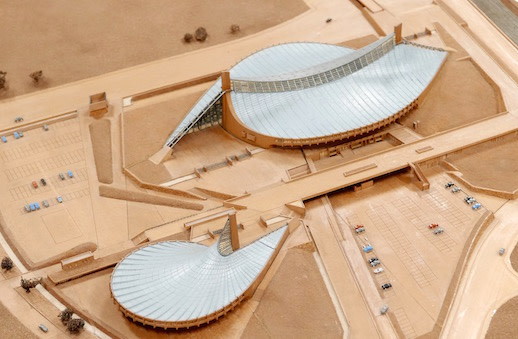

Autor: Kenzo Tange
Localización: Tokyo
Superficie total : 34,204 m2
Cronología: 1964
Biografía del autor
Kenzo Tange nació en un pequeño pueblo de Isla Shikoku, Japón el 4 de septiembre de 1913. Estudió arquitectura e ingeniería en la Universidad de Tokio y se convirtió en profesor en 1946. En la misma universidad fundó Tange Lab, formando a famosos arquitectos como Maki Fumihiko o Arata Isozaki. Se les encargó la reconstrucción de Hiroshima, que fue destruida por la bomba atómica.
En la zona más bombardeada, Tange construyó el Parque de la Paz, un museo y símbolo de paz que se convirtió en un referente internacional de la modernización de Japón. La mayor parte de su estructura es de hormigón armado. Durante la década de 1950, diseñó edificios públicos, edificios del parlamento, bibliotecas y ayuntamientos.
En 1958, su estilo se consolidó en la oficina de Takamatsu de la prefectura de Kagawa, un edificio de nueve pisos en el que apareció un sistema de vigas y columnas de hormigón pretensado. Para los Juegos Olímpicos de Tokio de 1964, construyó dos pequeños estadios con candados. La Catedral Católica de la capital japonesa (1965) se centra en una aguja espiral de hormigón y vidrio rodeada por cuatro casquetes parabólicos de acero inoxidable.
Fue el responsable del plan maestro para la Exposición Universal de 1970 en Osaka y, a partir de este encargo, su enfoque estilístico evolucionó hacia una arquitectura más orgánica. Kenzo Tange murió en su casa de Tokio el 22 de marzo de 2005, a la edad de 91 años.
Contexto cultural y descripción de la obra
El Gimnasio Nacional Yoyogi es un edificio que funciona como estadio deportivo. Fue construido en Tokyo Dan durante los Juegos Olímpicos de Verano de 1964. Diseñado por Kenzo Tange, uno de los arquitectos modernistas más famosos de Japón, este gimnasio es una mezcla de la estética modernista occidental y la arquitectura japonesa tradicional.
Este edificio tiene un diseño arquitectónico distintivo, famoso por su diseño de techo suspendido. El estadio tiene una capacidad de 13.291 y actualmente se utiliza principalmente para hockey sobre hielo y baloncesto. El concepto de espacio es original y audaz. Ambos edificios utilizan los últimos sistemas estructurales, como la catedral de Santa María con una carpa y un sistema de cables de acero que funciona como una fuerza de tracción integrada para todos los elementos.
La estructura del techo de cables de acero tiene forma de parábola hiperbólica. El hueco detrás de la marquesina está acristalado, mezclandose con la construcción de iluminación artificial. La estructura principal del gimnasio es un edificio de planta rectangular que se estrecha hacia arriba. En este edificio, Tange mezcla la sotifiscación de la tecnología estructural del siglo XX con una estructura moderna, a saber, una carpa y un sistema de cables de acero que actúa como una fuerza de tracción integrada. resiste todos los elementos. Eligió la estructura de techo de cable de acero porque la estructura de acero a la tracción era un elemento arquitectónico importante en ese momento y la estructura de acero a la tracción tenía una alta resistencia a la tracción y a la tracción.
El concepto aplicado al Gimnasio Nacional Yoyogi, del arquitecto Kenzo Tange, tomó algunos elementos clásicos del techo del santuario sintoísta, característico de Japón.
Bibliografía:
Safitri, E. (2014, 2 noviembre). Yoyogi National Gymnasium «Study Analysis». «https://www.academia.edu/9093798/Yoyogi_National_Gymnasium_Study_Analysis_»
Vallejo,E.L.(2017, 4 diciembre). Kenzo Tange. «https://www.academia.edu/35339531/Kenzo_Tange»
Claros,B.C.(2016, 25 octubre). KENZO TANGE. «https://www.academia.edu/29411849/KENZO_TANGE»
Gimnasio Nacional de Tokio - Ficha, Fotos y Planos. (2020, 19 octubre). «WikiArquitectura. https://es.wikiarquitectura.com/edificio/gimnasio-nacional-de-tokio/»
Torrijos, G. (2005, 5 abril). Kenzo Tange, el arquitecto que transformó Tokio. El PaÃs. «https://elpais.com/diario/2005/04/05/agenda/1112652009_850215.html»
Honoring the Legacy of Kenzo Tange. (s. f.). Tokyo Art Beat. «https://www.tokyoartbeat.com/en/articles/-/honoring-the-legacy-of-kenzo-tange»
KENZO TANGE: GIMNASIO NACIONAL DE YOYOGI, TOKIO. (2011, 5 octubre). Pinterest. «https://www.pinterest.es/pin/643522234224478049/»
4 notes
·
View notes
Text
Human Dignity and Work
On March 26, 2024, the Francis Scott Key Bridge in Baltimore collapsed when a container ship crashed into it. Six workers lost their lives when this happened, six immigrant workers who were pursuing the American dream. They were from Mexico, El Salvador, Guatemala, and Honduras.
The loss of these immigrants demonstrates the role that the immigrant communities continue to have building the infrastructure of our great nation. The following excerpt from a Reuters news story covering this incident offers a narrative on the plight of our immigrant workforce.
Hispanic workers are more likely than other racial and ethnic groups to die on the job, according to the U.S. Bureau of Labor Statistics, with construction being a particularly deadly industry.
“The only choice is to work, when you don’t have the same salary that a citizen might earn,” said Carlos Crespo, 53, a mechanic from Mexico. “Many don’t value our Hispanic community. They see us as animals or think that we live off the government. But that is not true, we pay our taxes too,” he said.
This incident is part of our American narrative. This nation has been built by immigrant hands who tragically suffered in the economic development of this nation. On March 22, 1911 one hundred and forty six immigrant women, tragically died in Manhattan during the terrible Triangle Shirtwaist Factory Fire. This truth is memorialized in our popular culture and it has spurred good working conditions and regulations. But as you can see, the story continues to this very day.
The dignity of work is seen as a social principle of the Catholic Church. For the Church, the economy must serve people, not the other way around. Work is more than a way to make a living; it is a form of continuing participation in God’s creation. If the dignity of work is to be protected, then the basic rights of workers must be respected--the right to productive work, to decent and fair wages, to the organization and joining of unions, to private property, and to economic initiative. This was expressed early on as Pope Leo XIII gave rise to what we now call the social teachings of the Church.
The working man, too, has interests in which he should be protected by the State… We may lay it down as a general and lasting law that working men's associations should be so organized and governed as to furnish the best and most suitable means for attaining what is aimed at, that is to say, for helping each individual member to better his condition to the utmost in body, soul, and property. - Pope Leo XIII, Rerum Novarum, 1891
Pope Francis reminds us of this sacred value as he expresses his concern for those who are unemployed or who are exploited in their workplace. “labor is often a hostage to social injustice and, rather than being a means of humanization, it becomes an existential periphery.” Labor that is just and fair allows to further develop our God given dignity by participating in the development of our communities. This social principle of course assumes and recognizes a truth that society does not often reveal to us, that we, by our very nature, are people imbued with dignity. The Catholic Church has always professed this truth as a fundamental tenant of our faith. This was recently expressed by Pope Francis:
Every human person possesses an infinite dignity, inalienably grounded in his or her very being, which prevails in and beyond every circumstance, state, or situation the person may ever encounter. This principle, which is fully recognizable even by reason alone, underlies the primacy of the human person and the protection of human rights. - Pope Francis, Dignitas Infinitum, 2024
Labor is then a fundamental way of expressing our dignity. Pope Francis explored this in his book "Let Us Dream: The Path to a Better Future" when he suggested that three social issues must be addressed as we look to the future of our Catholic social priorities: Land/Tierra, Lodging/Techo, and Labor/Trabajo.
God gave us the land to till and keep. Our work is the basic condition of our dignity and well-being... That is why, as a society, we have to ensure that labor be a means not just of earning but of self-expression, of taking part in society, and of contributing to the common good. Prioritizing access to work must become a core goal of national public policies. (Francis, pg. 131)
These are the values we must keep in mind as we consider issues such as access to employment and just wage. Pope Francis also has us consider the idea of a Universal Basic Income (UBI), reduced working hours and adjusted salaries. America has a history of taking advantage of migrant and minority communities but we know that has never been just or fair. This nation struggled with slavery and forced labor. We knew that it was not consistent with our American values, eventually our history will testify to the fact that we cannot accept these social injustices. In a similar way we cannot allow any group to continue being victims of the market's greed. Catholics have the benefit of our social teaching to remind us that these social injustices cannot be tolerated. But we just need to take the time to reflect on them.

0 notes
Text
Por cierto..el Super_yate BRAVO EUGENIA es del DUEÑO de los DALLAS COWBOYS dedicado a su mujer por lo que recuerdo que estando de visita [estuve como 3 o 4 veces pues tiene hasta casino] en mayo 2009 en MELIA [luego HILTON] CARIARI de SAN JOSE DE COSTA RICA para recordar que mi padre me llevo en julio 2005 tras salir del psiquiátrico y enseñarme todo lo que hizo en los 70 como fue el canal 13 o SINART [sistema nacional de radio y Tv] ..estando en habitación 1109 [11 de sep] pareada a la 1111 junto a la piscina..tras hablar con la tripulación de IBERIA del VIRUS H1V1 hable con un cubano que era corredor de BOLSA y estaba en el JACUZZI de AGUA VOLCANICA ..por lo que al llevar la gorra de los JAGUARS de JACKSONVILLE [que compre al verlos jugar un amistoso de pretemporada con DEL_FIN_ES de MIAMI que empezaron ganando 13_0 ese 16_8_08 y estaban en mi hotel HYATT a la rivera del RIO ST JOHN]..me hablo de que ver toda la FAMILIA a los DALLAS COWBOYS era una RUINA y cuyo anterior estadio tenía un agujero en el techo porque se arrepentirán de cerrarlo por lo que decían que era por donde veía DIOS y estadio donde toco en uno por 1era vez GUNS N ROSES como telonero de INXS en su gira CALLING ALL NATIONS así como con IGGY POP y ZIGGY MARLEY aunque se lo arruino el HURACAN GILBERT [sep'88] que salio a FILMARLO o a su encuentro HUTCHENCE.
Y al agacharme para escucharle se me cayó el móvil del bolsillo de la camisa y le hize bucear al CUBANO estropeandose solo la función memoria extraible
A lo mejor el YATE BRAVO EUGENIA ya no sale de mi IMPERIO DEL SOL










0 notes
Text
¿Por qué el Rassemblement National francés no libra la batalla cultural?

«Es la octava vez que el apellido Le Pen es derrotado.» Recordemos esta frasecita de Éric Zemmour, sin duda torpe, tras el fracaso de Marine Le Pen en la segunda vuelta de las elecciones presidenciales de 2022. El pasado 7 de julio, Zemmour podría haber añadido una novena derrota a esta extraña lista de logros. La cuestión de saber si le Rassemblement National [Agrupación Nacional. En lo sucesivo, RN] superará el mal fario de las elecciones sigue abierta. Existen dos hipótesis: la del techo de cristal y la de la meseta. La primera postula que existe un umbral incompresible por encima del cual el RN no puede subir; la segunda cree, por el contrario, que sólo es cuestión de tiempo y de ganancias marginales para obtener una mayoría. Entonces, ¿por qué no? Imaginemos, pues, como en los problemas escolares, que el RN llegara al poder. ¿Sería realmente capaz de ejercer el poder? ¿Aceptarían los órganos del Estado, grandes y pequeños, obedecer a un ejecutivo «azul Marina»?
Entre las dos vueltas de las pasadas elecciones legislativas, todos vimos cómo el impulso electoral del RN, que hasta entonces había parecido irresistible, se rompía ante un insuperable alud «republicano»: un «cordón sanitario» que se volvió a formar espontáneamente y al que se sumaron los votos del Nuevo Frente Popular junto con el apoyo casi unánime de la sociedad civil. ¿Qué ocurrirá con este frente, aunque se resquebraje, si el RN toma el poder? ¿Volverá a activarse, y bajo qué forma? ¿La extrema izquierda tomando las calles? ¿La desobediencia civil desembocando en el caos institucional? Es demasiado pronto para decirlo.
Todo el mundo es libre de especular sobre la naturaleza y la legitimidad de este cordón sanitario «republicano». Sin embargo, lo que debería cuestionarse son más bien las condiciones que lo hacen posible. Lo cierto es que con la naturaleza política ocurre como con todo lo demás: aborrece el vacío. Este cordón sanitario nunca habría alcanzado tal intensidad si no hubiera sabido aprovechar el aislamiento de l RN y su incapacidad para recurrir a amplios sectores de la sociedad civil para contrarrestar sus efectos. Ahora bien, es a la sociedad civil a quien le corresponde construir lo que Antonio Gramsci, el gran teórico del combate cultural, llamaba el «consenso-consentimiento». ¿Cómo hacerlo? Produciendo los enunciados de referencia, asegurando así la dirección de las mentes a través de lo que Gramsci denominaba los «aparatos de la hegemonía», pues la hegemonía no es otra cosa que la capacidad de transformar la ideología de un grupo social en creencias universalmente recibidas y que todos aceptan sin discernir.
Es este poder, el poder cultural, el que controla a los demás poderes. No puede haber victoria política duradera sin hegemonía ideológica. ¿Qué sería del poder político sin el poder cultural? Sería algo hemipléjico e impotente, sobre todo en las viejas democracias liberales, donde la sociedad civil está firmemente asentada y coproduce el poder político desde el siglo XVIII.
Desde hace algunos años se llevan publicando numerosos artículos que destacan la victoria ideológica del RN. Es un poco precipitado. A excepción del campus de Héméra, la escuela de formación y cultura política de RN, que se inaugurará en 2023, el partido de Marine Le Pen no ha hecho de la batalla cultural una prioridad, al menos desde que Bruno Mégret abandonó el partido en 1998. Tarda en llegar. ¿Dónde están los Sartre, Aragon, Yves Montand y Jean Ferrat del RN? En su momento, el PCF supo atraerlos.
Algunos dirán extraoficialmente que ser del RN es condenarse a la muerte social. Pero hay formas de evitarlo. La primera es crear un ecosistema militante. En la época de los megretistas[1], hace 30 años, lo que entonces era el Front National creó un Consejo Científico. Incluía a sociólogos de primera fila como Jules Monnerot y a una serie de académicos de renombre. Hoy, los resultados son escasos, si de deja de lado el ensayista Hervé Juvin y el politólogo Jérôme Sainte-Marie. ¿Dónde están los intelectuales orgánicos del RN, sus defensores mediáticos, sus embajadores culturales, sus conferenciantes, su aparato hegemónico, sus grupos de reflexión, sus periódicos, sus think-tanks, sus editoriales?
La misión de estas estructuras es crear y organizar la hegemonía cultural, de la que son mediadores privilegiados, favoreciendo la emergencia de una «nueva intelectualidad», es decir, de una contracultura. Es una tarea a largo plazo. Mientras tanto, el RN podría haberse apoyado al menos en los «intelectuales tradicionales», conservadores y católicos. Pero apenas lo ha hecho. Basta pensar en la negativa a escuchar a los zemmourianos y a los autores nacidos en la estela de la Manif pour tous[2]. Peor que un crimen, fue un error.
Se cita a menudo la entrevista que, en vísperas de las elecciones presidenciales de 2007,Nicolas Sarkozy concedió, al dictado de Patrick Buisson, al Figaro Magazine. En ella, el futuro presidente de la República hacía suyo «el análisis de Gramsci: el poder se gana a través de las ideas». Fue la primera vez que un hombre de derechas emprendía tal batalla. Nada parecido ha hecho el RN. El resultado es que aún no ha habido un momento gramsciano para el RN, porque este partido pensó que podía prescindir de un «gramscianismo de derechas», a diferencia de Éric Zemmour o de Marion Maréchal, que siempre han asumido esta dimensión de la lucha política.
Una cosa es ser todopoderoso en TikTok,[3] y otra muy distinta ser un productor de ideas. Nadie niega la necesidad de comunicadores, pero éstos no pueden escribir el guion por sí solos. Para ello se necesitan muchas otras cosas, empezando por una teoría del combate cultural respaldada por un mecanismo operativo ad hoc. La caja de herramientas del RN no parece tenerlo. Para ponerse contento basta con tener electores, pero los lectores parecen estar de más en esta ecuación. Desde sus primeros éxitos, el RN ha optado por prescindir de los organismos intermediarios, prefiriendo dirigirse directamente a sus electores y haciendo como si la sociedad civil no existiera. Pero la sociedad civil es una realidad con la que hay que contar, y el lenguaje que le dirigimos es ante todo metapolítico, es decir, ideológico. Sin esa herramienta, nos vemos reducidos a imitar el lenguaje de nuestro adversario.
Si se escrutan las insuficiencias del RN, uno llega a pensar que la principal debilidad de sus dirigentes parece residir en la precariedad de su estatus social, como si hubieran interiorizado su condición de dominados en casi todos los ámbitos, en los medios de comunicación, en los hemiciclos, en las universidades, etc. Al optar por el sigilo y el perfil bajo, el RN está consintiendo ser dominado en los discuros, del mismo modo que su electorado, el cual también está dominado, estigmatizado e inferiorizado, y no tiene ninguna contranarrativa en reserva para oponerse a la narrativa dominante.
Para comprender la situación del RN y dotarnos de los medios para reflexionar sobre la condición histórica de sus electores, debemos recurrir a los conceptos desarrollados por las ciencias sociales, todas ellas comprometidas con el wokismo y el izquierdismo cultural, para volver dichos conceptos contra el wokismo y el izquierdismo cultural. Los conceptos de «dominación», «discriminación sistémica», «privilegio», «invisibilidad», «política de reconocimiento» e «inclusión» están hechos a medida para el RN. De hecho, votar a este partido no está asociado a ningún prestigio social. Al contrario, lo que domina las representaciones es la condescendencia, cuando no el desprecio, de una gran parte de la sociedad civil, que mira a este partido de lejos y de soslayo.
El núcleo sociológico del electorado del RN pertenece a las clases «bajas». ¿Qué es lo característico de estas clases? No tienen ninguna legitimidad cultural, hasta el punto de que son tan inaudibles como invisibles. Del mismo modo que existen ondas luminosas (infrarrojas, por ejemplo) que el ojo humano no percibe, existen categorías sociales que el ojo social no ve. Se trata de una forma de «daltonismo» (otro concepto de las ciencias humanas que puede ser mal utilizado).
Ninguna serie de Netflix o telefilme de France Télévisions presenta a estas categorías sociales. La televisión las desprecia con una buena conciencia que roza el racismo de clase. Arcom es el primero en saberlo, ya que realiza estudios sobre la representatividad de las categorías socioprofesionales en televisión (y no sólo de las minorías visibles, aunque sólo se hable de ellas). Los altos ejecutivos, que sólo representan el 10% de la población, constituyen el 65% de las personas que hablan en las cadenas de TDT. Mientras que los obreros, que representan el 12% de la población, sólo ocupan el 2% del tiempo de emisión. Los asalariados y las clases medias no están mucho mejor. Solían ocupar un lugar destacado en los programas de Cyril Hanouna, pero el regulador ha decidido dsesconectar el C8 y el TPMP, no sin cierta incoherencia, ya que es el primero en estar de acuerdo en que «la televisión presenta una imagen muy urbana de la sociedad». La ceremonia de apertura de los Juegos Olímpicos fue un buen recordatorio de ello, aunque a María Antonieta ya no le corten la cabeza, sólo el micrófono. Lo que conduce, volens nolens, al mismo resultado.
Así que se trata de un doble golpe para las clases populares. Privadas de expresión política por el cordón sanitario republicano, se ven privadas de expresión mediática. Así es como funcionan los Castores del aluvión político y los Pollux del filtrado mediático. Este proceso de invisibilización funciona a todos los niveles. Sorprendentemente, los dirigentes del RN están de acuerdo con él y no encuentran nada que oponerle. Es la otra cara de la estrategia de normalización: una forma de discreción social, de aquiescencia involuntaria, de socavamiento doctrinal, que redobla la invisibilidad que sufre la Francia periférica. En estas condiciones, no hay ninguna posibilidad de elevarse al nivel de la hegemonía cultural.
En la «dialéctica del amo y el esclavo», el filósofo Hegel demostró que el esclavo puede revertir contra el amo la relación de dominación, pero sólo con una condición: siendo activo, trabajando, transformando el mundo, luchando por el reconocimiento y la visibilidad. Éstas son las cuestiones que están en juego en la batalla cultural para la derecha. Ser más proactivos, más ofensivos, más contraofensivos. Sobre todo porque el cordón sanitario republicano acabará apareciendo como lo que es: una afrenta democrática, la de una casta sin aliento que está quemando sus últimos cartuchos. «Las fuerzas reaccionarias en el umbral de su perdición», decía Mao Zedong, « lanzan necesariamente un asalto final contra las fuerzas revolucionarias» .
[1] Referencia a Bruno Mégret, antiguo dirigente del Front National que encabezó una orientación opuesta a Jean-Marie Le Pen y acabó derrotado por éste. (N. del Trad.)
[2] ‘Zemmourianos’, alusión a los partidarios de Éric Zemmour, agrupados en su partido Reconquête!
‘La Manif pour tous’: las grandes manifestaciones que hace unos diez años sacudieron a Francia en protesta contra la oficialización del “matrimonio” homosexual. (N. del Trad.)
[3] Alusión al gran número de seguidores de Jordan Bardella, el segundo de Marine Le Pensamiento. (N. del Trad.)
0 notes
Text
National Margarita Day in DC: Celebrating with specials at Mission Dupont, El Techo, and Le Sel
El Techo
As February 22 approaches, margarita enthusiasts in DC are gearing up to celebrate National Margarita Day in style. This iconic cocktail, known for its refreshing blend of tequila, lime juice, and orange liqueur, has captured the hearts of many, and local establishments are ready to mark the occasion with enticing specials and deals. Let’s delve into our picks for where to have an…

View On WordPress
0 notes
Text

Agnès Varda, pionera de la nouvelle vague y del cine feminista
Fotógrafa, artista plástica, directora de cine, guionista, artista, profesora de universidad, pedagoga, directora de fotografía, productora de cine, profesora y editora de cine
Varda dedicó gran parte de su energía al cine, aunque en la década de los años 50 había sido fotógrafa profesional e incluso fotógrafa titular del Festival de Aviñón cuando lo dirigía el igualmente mítico Jean Vilar.
Casi siempre hemos identificado a Agnès Varda con François Truffaut, Jean-Luc Godard o Claude Chabrol, referentes del movimiento francés de finales de los 50, la nouvelle vague, pero antes de que ellos filmaran Los 400 golpes (1959), Al final de la escapada (1960) o El bello Sergio(1958), Agnès Varda ya había rodado en 1954 su ópera prima La Pointre Courte, auténtica precursora estilística del movimiento.
Pocas cosas escapan a la atenta mirada de la cineasta francesa que continúa desafiando el lenguaje cinematográfico en cada película que estrena. Su humanidad, su sentido del humor, su energía desbordante recorren la historia del cine en sus más de 40 filmes, incluidos sus preciados cortometrajes
Varda estudió Historia del Arte en la École du Louvre antes de conseguir un trabajo como fotógrafa oficial del Teatro Nacional Popular ó Théâtre National Populaire (TNP) de París. Le gustaba la fotografía, pero estaba más interesada en el cine. Después de pasar unos días grabando la pequeña ciudad pesquera francesa de Sète, en el barrio «La Pointe Courte», para un amigo con una enfermedad terminal que no podría visitarla por sí solo, Varda decidió hacer una película. De este modo aparece en 1954 su primera película, La Pointe Courte, que narraba la historia de una triste pareja y su relación en la pequeña ciudad. La película es la precursora estilística de la Nouvelle vague francesa.
Sus películas, documentales y vídeo-instalaciones guardan un carácter realista y social. Toda su obra presenta un estilo experimental distintivo.
A lo largo de su trayectoria ha recibido numerosos premios, entre ellos en 1985 con la película Sans toit ni loi (Sin techo ni ley) obtuvo el León de Oro del Festival de Cine de Venecia y su biografía documentada en Las playas de Agnès el Premio César en 2009 o el Premio René Clair de la Academia francesa. En 2017 recibió el Óscar Honorífico por su carrera.
0 notes
Text
នយោបាយ ១៥ចំណុច សម្រាប់រាជរដ្ឋាភិបាលអាណត្តិទី៧
MLMUPC យុទ្ធសាស្រ្តបញ្ចកោណ for Smart City
By MLMUPC UPC October 25, 2023

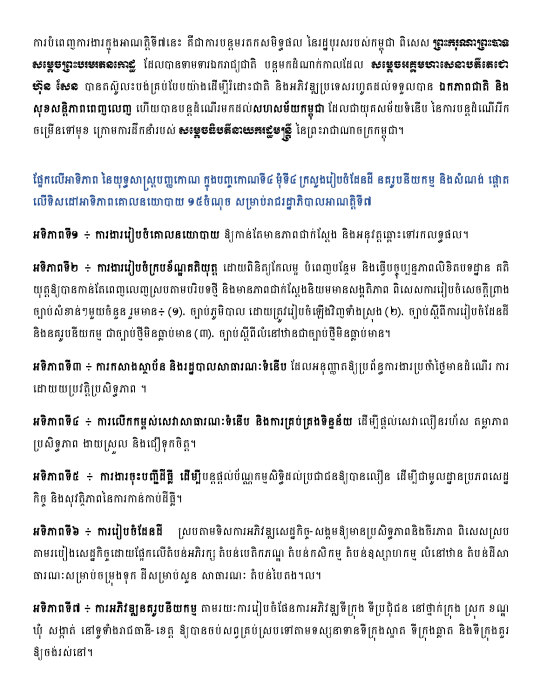
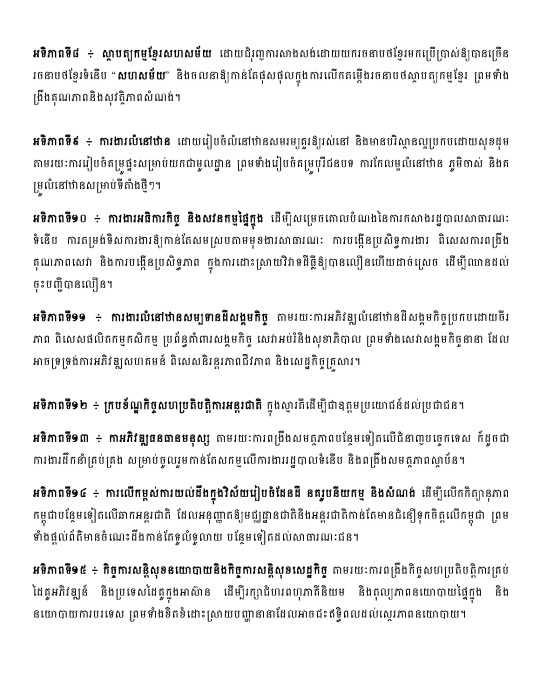
Based on the priorities of the Pentagon Strategy in the fourth Pentagon and the fourth angle, the Ministry of Land Management, Urban Planning, and Construction focuses on 15 policy priorities for the seventh-term government
ផ្អែកលើអាទិភាពនៃ យុទ្ធសាស្រ្តបញ្ចកោណ ក្នុងបញ្ចកោណទី៤, មុំទី៤, ក្រសួងដែនដីនគររូបនីយកម្ម និងសំណង់ផ្តោតទៅលើទិសដៅអាទិភាពគោលនយោបាយ ១៥ចំណុច សម្រាប់រាជរដ្ឋាភិបាលអាណត្តិទី៧
Priority 7 ៖ Urban development through urban development planning at the municipal, district, Khan, commune, and Sangkat levels throughout the capital - province following the concept of a clean city, smart city, and desirable city to live in
អទិភាពទី៧ ៖ ការអភិវឌ្ឍន៍នគររូបនីយកម្ម: តាមរយៈការរៀបចំផែនការអភិវឌ្ឍទីក្រុង ទីប្រជុំជន នៅថ្នាក់ក្រុង ស្រុក ខណ្ឌ ឃុំ សង្កាត់ នៅទូទាំង រាជធានី ខេត្តឱ្យបានចប់សព្វគ្រប់ស្របទៅតាមទស្សនាទានទីក្រុងស្អាត ទីក្រុងឆ្លាត និងទីក្រុងគួរឱ្យចង់រស់នៅ
The implementation of the work in this seventh mandate is a continuation of the achievements of the Cambodian statesmen, especially His Majesty Preah Bat Samdech Preah NORODOM SIHANOUK “Preah Borom Ratanak Kaudh, who demanded national independence and followed the stage where Samdech Akka Moha Sena Padei Techo Hun Sen sacrificed everything to liberate the nation and develop the country until there was complete national unity and peace and to continue to travel to contemporary Cambodia, which is the modern era of continuing to progress under the leadership of the Samdech Thipadei, Prime Minister of the Kingdom of Cambodia.
The Cambodian Ministry of Land Management, Urban Planning and Construction (MLMUPC) has initiated a Smart City plan to develop sustainable and technologically advanced urban areas in Cambodia. The plan aims to improve the efficiency of public services, enhance infrastructure, and promote economic growth through the use of innovative technologies.
"Having the right Mindset and Tool for the Job matters in business"
Sonetra KETH (កេត សុនេត្រា)
Architectural Manager/Project Manager/BIM Director
RMIT University Vietnam + Institute of Technology of Cambodia
0 notes
Text
2001 - More interesting entries
Focusing this year on two countries: Germany and Portugal (with a hint of Spain).
Germany has for several years now gone for it. 2001 was a classic example of this
youtube
Münchener Zwietracht feat. Rudolph Moshammer - "Teilt Freud und Leid" - I am just at a loss to try explaining this.
youtube
DJ Balloon - "Techo Rocker". Someone in Germany discovered the Master Fatman editions of DMGP.
youtube
Zlatko - "Einer fuer alle". Live from the first edition of German Big Brother, here's its star. Trying his best bless him.
Onto Portugal which had a national final featuring 50 songs a year after one with only 8. This leads to lots of entries such as these.
youtube
Psique - "Pensar Assim".
youtube
Patty - "Sempre Sonhei" - this one is going OK until she reaches the operatic section at which point she actually surprises herself with her voice.
Lastly Spain and a group of camp cowboys who know their way around a fan. The 'official' upload of this doesn't have the live singing. However the live version is on Youtube...
youtube
Locomía - "Música música" - this was the first song on stage for Eurocanción 2001. The next year, TVE changed their qualifying competition for Operación Triunfo competitors.
0 notes